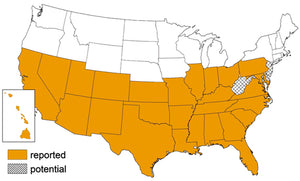New Study Shows Bed Bugs can Transmit Disease
Parasitic Disease Carried by Bed Bugs

Photo by Kim Jung
The moment anyone with bed bug experience has come to fear is here: we have proof that bed bugs can be carriers of disease. University of Pennsylvania Medicine researchers and the Center for Clinical Epidemiology and Biostatistics recently published a study showing that bed bugs are able to transmit the parasite that causes Chagas disease in their feces. The researchers exposed mice infected with the parasite to bed bugs and monitored the results. At the end of the experiment the majority of the 2000 bed bugs were infected with the parasite, despite only being exposed in small groups for three days at a time. Unfortunately for us they were also able to show that the bed bugs could then pass along the disease. Infected bed bugs were put in an enclosure with uninfected mice for a month, at the end of which 75% of the mice were now infected with the parasite. The bed bugs didn’t just pass along the parasites; they also proved to be great hosts, surprising the study authors with how well the parasite was able to replicate inside the bed bugs.
Chagas Disease
Chagas disease has been known across Latin America for over a century and was already transmitted primarily by bugs, although until now it was thought that only triatomine bugs (aka kissing bugs) could spread it. The mechanism of infection was the same for bed bugs in this study. The triatomine bugs are infected with Trypanosoma cruzi parasites which are expelled in the bug feces, allowing them to easily spread into the open wounds caused by bug bites or any other scratches on the skin. The parasite is also able to permeate mucous membranes, making it possible for infections to start through contact with your eyes or by ingesting contaminated food.
Chagas disease has two stages: acute and chronic. In the initial acute stage patients frequently have no symptoms at all, allowing the parasite to spread throughout the blood stream silently. Others experience fever and severe swelling that can last for up to a few months. If left untreated chronic Chagas disease will occur, which is often incurable and lifelong. This can be asymptomatic for some people but could be devastating, especially when the disease damages the heart or digestive system. Currently an estimated 50,000 people die annually of Chagas.
Areas of Infection
Although Chagas disease is most prevalent in Latin America it can also be found in the United States. The first confirmed bug-to-human infection here was in Louisiana in 2007. Triatomine bugs are prevalent throughout the southern United States, and in Louisiana alone it was estimated that at least 30% of wild opossums and armadillos were infected as of 2007. The CDC lists Chagas disease as a “neglected parasitic infection,” a group of diseases normally associated with low-income countries that are relatively ignored here despite infections occurring in the United States. As of now they estimate that some 300,000 living Americans are infected with Chagas disease, although the vast majority of these cases were originally infected in other countries.

Triatomine Bugs in the USA – Image from cdc.gov
Worrying Results
The ability of bed bugs to transmit the parasite in their feces presents a new avenue for infection to spread throughout the United States. Although triatomine bugs are found across the southern states they are more prevalent in nature and prefer living in mud or thatch dwellings not typically found here. Bed bugs, on the other hand, thrive with human contact and can be found everywhere from small towns to large metropolises like New York City. Triatomine bugs are also relatively easy to kill, but the increasing resistance of bed bugs to available pesticides makes this threat all the more real. Even the study’s authors expressed concern: the ability of Chagas disease to be asymptomatic during the acute (and treatable) stage before progressing into its chronic, life-threatening form means that populations of bugs could already be transmitting Chagas without us even knowing it.
Posted by Rose Eckert-Jantzie


